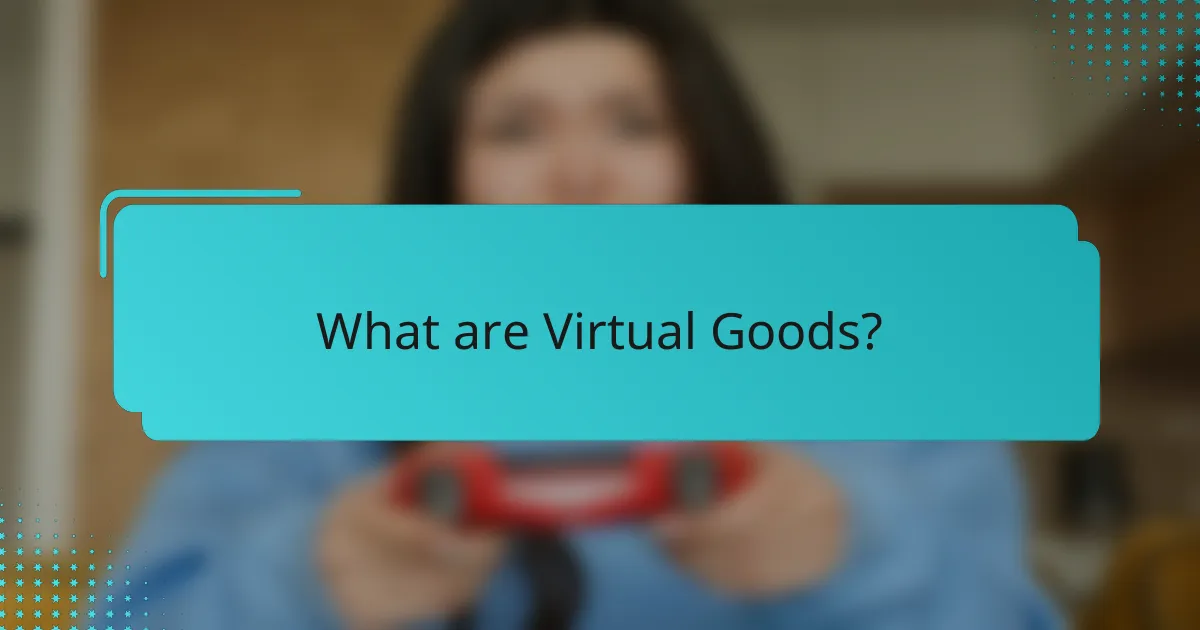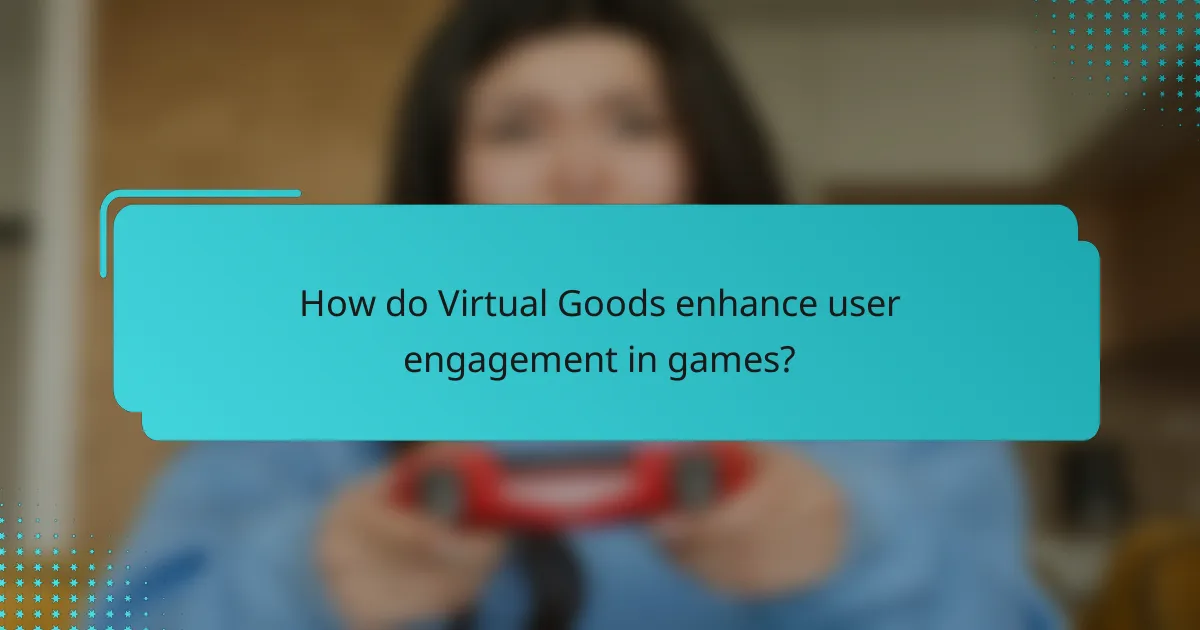
What are Virtual Goods?
Virtual goods are digital items that can be purchased, earned, or traded within virtual environments. These goods often enhance user experience in online games and social platforms. Examples include in-game currency, skins, and virtual real estate. Virtual goods can be categorized into consumables, collectibles, and enhancements. They play a significant role in user engagement, often driving monetization strategies for developers. The global market for virtual goods was valued at approximately $50 billion in 2020, indicating their importance in the digital economy.
How are Virtual Goods defined in the context of gaming?
Virtual goods in gaming are digital items that players can acquire and use within a game environment. These items can include virtual currency, skins, characters, or enhancements. Players often purchase virtual goods with real money or earn them through gameplay. The concept of virtual goods is critical in the gaming industry, as they contribute to player engagement and monetization strategies. According to a report by Newzoo, the global gaming market generated over $159 billion in 2020, with a significant portion attributed to virtual goods sales. This highlights their importance in driving revenue for game developers and publishers.
What are the key characteristics of Virtual Goods?
Virtual goods are digital items that exist within a virtual environment. They can include in-game items, skins, or avatars. Virtual goods are intangible and cannot be physically touched. They are often purchased with real money or in-game currency. Ownership of virtual goods is usually tied to user accounts. Their value can fluctuate based on demand and rarity. Virtual goods enhance user experience and engagement in games. Many games utilize virtual goods to generate revenue through microtransactions.
How do Virtual Goods differ from physical goods?
Virtual goods are intangible items, while physical goods are tangible and can be physically touched. Virtual goods exist in digital environments, such as video games or online platforms. They can include items like skins, avatars, or in-game currency. Physical goods, on the other hand, include products like clothing, electronics, or furniture.
The production and distribution of virtual goods occur through digital transactions. This process often involves lower costs compared to manufacturing physical goods. Virtual goods can be replicated easily without additional cost. In contrast, physical goods require raw materials and logistics for delivery.
Ownership of virtual goods is often governed by user agreements. This can limit the rights of users compared to ownership of physical goods. For example, users may not have the ability to resell virtual items. Physical goods can be sold or transferred freely.
The market for virtual goods is rapidly growing. In 2020, the global market for virtual goods was valued at approximately $50 billion. This growth highlights the increasing importance of virtual goods in digital economies.
What types of Virtual Goods are commonly used in games?
Common types of virtual goods used in games include in-game currency, skins, and power-ups. In-game currency allows players to purchase items or upgrades. Skins are cosmetic changes to characters or items. Power-ups provide temporary boosts to gameplay. Other types include virtual pets, avatars, and loot boxes. These goods enhance player experience and engagement. The popularity of these items is evident in mobile and online gaming markets. For example, in 2021, the global market for virtual goods was valued at approximately $50 billion.
What are consumable Virtual Goods?
Consumable virtual goods are digital items that provide temporary benefits or enhancements in a game. These goods are used once or for a limited duration before they are depleted. Examples include in-game health potions, temporary power-ups, or limited-use weapons. Players purchase or earn these items to improve their gaming experience. The consumption of these goods often influences user engagement and spending behavior. Research indicates that consumable items can drive in-game purchases, as they create a sense of urgency and immediate gratification for players.
What are cosmetic Virtual Goods?
Cosmetic virtual goods are digital items that alter the appearance of a character or object without affecting gameplay functionality. These items include skins, outfits, and accessories in video games. Players often purchase cosmetic virtual goods to personalize their gaming experience. The demand for these items has increased significantly in online gaming communities. According to a report by SuperData Research, cosmetic items account for a substantial portion of in-game purchases. This trend highlights the importance of aesthetics in player engagement. Cosmetic virtual goods serve as a means for self-expression in gaming environments. They do not provide any competitive advantage, focusing solely on visual appeal.
What are functional Virtual Goods?
Functional virtual goods are digital items that provide specific benefits or enhancements within a virtual environment. These goods can improve a player’s experience by offering advantages such as increased abilities, access to new areas, or customization options. For example, in a video game, a functional virtual good might be a special weapon that boosts a player’s attack power. Studies show that players are more engaged when they can utilize these items effectively. Functional virtual goods often contribute to a game’s economy, encouraging users to purchase or earn them for better gameplay.

How are Virtual Goods priced?
Virtual goods are priced based on various strategies. Common pricing strategies include cost-plus pricing, competition-based pricing, and value-based pricing. Cost-plus pricing involves adding a markup to the production cost of the virtual goods. Competition-based pricing considers the prices set by competitors in the market. Value-based pricing focuses on the perceived value to the consumer rather than the cost of production.
Market demand also influences pricing. Higher demand can lead to increased prices. Additionally, psychological pricing tactics may be employed, such as setting prices just below a whole number to appear more attractive. In-game economies often adjust prices based on player behavior and spending patterns.
For example, a study by Hamari and Keronen (2017) highlights that player engagement can significantly impact the pricing strategies of virtual goods. This indicates that understanding user behavior is crucial for effective pricing.
What pricing strategies are used for Virtual Goods?
Virtual goods pricing strategies include freemium, in-app purchases, and dynamic pricing. Freemium models offer basic items for free while charging for premium features. In-app purchases allow users to buy virtual items or currency directly within the game. Dynamic pricing adjusts prices based on demand and user behavior. A study by NPD Group found that 50% of gamers engage with in-app purchases, supporting the effectiveness of these strategies. Additionally, games like Fortnite utilize limited-time offers to create urgency and boost sales.
How does dynamic pricing affect Virtual Goods?
Dynamic pricing significantly influences the market for virtual goods. It allows prices to fluctuate based on demand, user behavior, and market conditions. This strategy can enhance revenue for developers by capitalizing on peak user engagement times. For instance, during special events or promotions, prices may increase to reflect heightened demand. Conversely, prices may drop during off-peak times to stimulate sales.
Research indicates that dynamic pricing can lead to increased user engagement. A study by Chen et al. (2020) found that players are more likely to purchase virtual goods when prices are adjusted based on their purchasing patterns. This adaptability can create a sense of urgency among users. Users may feel compelled to buy virtual goods before prices rise.
Overall, dynamic pricing can optimize sales and enhance the user experience in virtual goods markets.
What role do discounts and promotions play in pricing?
Discounts and promotions significantly influence pricing strategies. They create perceived value, encouraging consumers to make purchases. Discounts can attract new customers and retain existing ones. Promotions can stimulate demand during slow sales periods. Research shows that 70% of consumers are motivated by discounts when making buying decisions. This highlights their effectiveness in driving sales. Overall, discounts and promotions are essential tools for optimizing pricing in competitive markets.
What factors influence the pricing of Virtual Goods?
The pricing of virtual goods is influenced by multiple factors. Demand for the virtual goods significantly affects their price. Higher demand typically leads to increased pricing. Supply also plays a crucial role; limited availability can drive prices up. The perceived value of the virtual goods can impact pricing as well. Items considered rare or exclusive often command higher prices. Market trends and competitor pricing strategies can influence how virtual goods are priced. Additionally, the platform on which the goods are sold can affect pricing structures. For instance, mobile games may have different pricing strategies compared to PC games.
How do player demographics impact pricing strategies?
Player demographics significantly impact pricing strategies in the gaming industry. Different age groups, income levels, and geographic locations influence purchasing behavior. For instance, younger players may prefer lower-priced items due to limited disposable income. Conversely, older players often have more financial resources and may be willing to spend more on premium content.
Additionally, geographic factors can affect pricing strategies. Players in regions with higher disposable income may respond positively to higher price points. In contrast, markets with lower income levels may require more competitive pricing to drive sales.
Research shows that tailoring pricing strategies to demographic segments can increase revenue. A study by NPD Group highlighted that understanding player demographics leads to better-targeted marketing and pricing approaches, maximizing engagement and sales.
What is the significance of market demand in pricing?
Market demand significantly influences pricing strategies for virtual goods. High demand typically leads to higher prices as consumers are willing to pay more for sought-after items. Conversely, low demand often results in lower prices to stimulate sales. This relationship is evident in dynamic pricing models used in gaming, where prices fluctuate based on player interest. For example, limited-time offers capitalize on heightened demand, driving up prices during peak interest periods. Understanding market demand helps developers optimize revenue and align pricing with consumer willingness to pay.

How do Virtual Goods enhance user engagement in games?
Virtual goods enhance user engagement in games by providing players with incentives to participate actively. They offer a sense of accomplishment and progression, which keeps players motivated. Players often purchase or earn virtual goods to customize their avatars or enhance gameplay experiences. This personalization creates a deeper emotional connection to the game.
Research indicates that players are more likely to remain engaged when they have access to exclusive items. A study by Hamari and Koivisto (2015) shows that virtual goods can significantly increase user retention rates. Additionally, the social aspect of sharing virtual goods with friends fosters community interaction. This interaction further increases overall game enjoyment and player loyalty.
What are the psychological effects of Virtual Goods on players?
Virtual goods can significantly impact players’ psychological states. They often enhance feelings of achievement and satisfaction. Players may experience a sense of ownership and identity through virtual goods. This can lead to increased engagement and time spent in games. Research shows that virtual goods can trigger reward mechanisms in the brain. For example, a study by Hamari and Keronen (2017) found that players derive pleasure from acquiring and using virtual items. Additionally, virtual goods can foster social connections among players. They may facilitate interactions and competition, enhancing the overall gaming experience.
How do Virtual Goods create a sense of achievement?
Virtual goods create a sense of achievement through their ability to signify progress and reward effort. Players often invest time and resources to acquire these digital items. This investment leads to a feeling of accomplishment when they successfully obtain or unlock them. For example, in many games, achieving a rare item can boost a player’s status among peers. Additionally, virtual goods often come with unique attributes that enhance gameplay, further reinforcing the player’s sense of mastery. Research indicates that players who engage with virtual goods report higher satisfaction levels and increased motivation to continue playing.
What role do Virtual Goods play in social interactions among players?
Virtual goods enhance social interactions among players by facilitating communication and collaboration. They serve as status symbols, allowing players to showcase achievements and preferences. Players often gift virtual goods to express friendship or appreciation, strengthening social bonds. Additionally, virtual goods can enable cooperative gameplay, where players must work together to acquire or utilize them. Research indicates that social interactions are significantly influenced by the presence of virtual goods in online gaming environments. For instance, a study by Hamari and Koivisto (2015) found that users engage more with games that incorporate social elements tied to virtual goods, reinforcing their social connections.
What strategies can developers use to increase engagement through Virtual Goods?
Developers can increase engagement through virtual goods by implementing several effective strategies. First, they can create limited-time offers to instill urgency. This can lead to increased purchase rates as users feel compelled to act quickly. Second, developers can introduce customization options for virtual goods. Personalization enhances user attachment and investment in their virtual items. Third, offering exclusive content or features tied to virtual goods can drive user interest. This exclusivity can motivate users to engage more frequently. Fourth, developers can utilize social sharing features related to virtual goods. Encouraging users to showcase their items can enhance community interaction. Additionally, providing rewards for engagement can incentivize users to interact with virtual goods more regularly. For instance, loyalty programs can reward consistent usage. Lastly, developers should analyze user behavior to tailor virtual goods to their preferences. This data-driven approach can lead to more relevant offerings, boosting engagement.
How can limited-time offers boost user engagement?
Limited-time offers can significantly boost user engagement by creating a sense of urgency. This urgency prompts users to act quickly to take advantage of the offer. According to a study by the Journal of Marketing Research, scarcity can increase perceived value, driving higher purchase rates. Users are more likely to engage when they feel they might miss out on a unique opportunity. Additionally, limited-time offers can encourage social sharing, as users may want to inform friends about the deal. This sharing can lead to increased visibility and further engagement within the community. Overall, the strategic use of limited-time offers effectively enhances user interaction and participation.
What are the benefits of user-generated content related to Virtual Goods?
User-generated content related to virtual goods enhances user engagement and fosters community interaction. It allows players to express creativity and share unique items or experiences. This content can lead to increased game retention as users feel a personal connection to the game. Additionally, user-generated content often drives word-of-mouth marketing, attracting new players. A study by the International Journal of Information Management found that user-generated content can increase user satisfaction by 20%. This demonstrates the tangible benefits of incorporating user-generated contributions into virtual goods ecosystems.
What best practices should developers follow when implementing Virtual Goods?
Developers should follow several best practices when implementing virtual goods. First, they should ensure that virtual goods enhance user experience. This can lead to increased engagement and retention. Second, developers should maintain transparency in pricing. Clear pricing helps users understand the value of their purchases. Third, they should offer a variety of virtual goods. Diverse options cater to different user preferences and motivations. Fourth, developers should implement fair monetization strategies. This prevents user frustration and promotes long-term satisfaction. Additionally, they should regularly analyze user feedback. This helps in refining the virtual goods offered. Lastly, developers should ensure compliance with legal regulations. Adhering to laws protects users and builds trust. These practices contribute to a successful implementation of virtual goods in games.
Virtual goods are digital items utilized within virtual environments, primarily in gaming and social platforms, that enhance user experience and engagement. This article covers the various types of virtual goods, including consumables, collectibles, and cosmetic items, as well as their pricing strategies such as dynamic pricing and in-app purchases. It also explores how virtual goods impact user engagement, drive monetization for developers, and influence player psychology through a sense of achievement and social interaction. Additionally, best practices for implementing virtual goods effectively in games will be outlined to ensure user satisfaction and compliance with regulations.